More info
Datasheet
| Minimum Tank Size | 25 litres / 6.60 US gallons |
| Maximum Size | 3.5cm / 1.38inches |
| Temperature | 22°C / 71.60°F - 28°C / 82.40°F |
| Hardness | 1.01dgH / 18ppm - 4.03dgH / 72ppm |
| pH | 3.0-6.5 |
General Description
Parosphromenus Nagyi, commonly known as liquorice gouramis or paros, is a small fish species belonging to the family Osphronemidae. They are distinguished by their short filamentous tip on their pelvic fins, unique color patterns, and small size, typically reaching up to 3.5cm in length. These labyrinth fishes are native to freshwater swamps and blackwater streams in Peninsular Malaysia, southern Thailand, Sumatra, and Borneo.
Aquarium Setup
Maintaining Parosphromenus Nagyi in an aquarium requires specific care. An adequately set up tank should be dimly lit, densely decorated with driftwood, branches, and clay pots providing shelter. The addition of dried leaf litter and Alder cones is recommended to mimic their natural habitat. Water conditions must be closely monitored, maintaining soft water with low general hardness and an acidic pH level ranging from 3.0 to 6.5 (see table).
Behaviour
Due to their conservation status and peaceful temperament, Parosphromenus Nagyi is not suitable for community tanks. It is advised to house them either alone or with small, peaceful cyprinids like Boraras or Sundadanio spp. Males may have territorial behavior during breeding, forming temporary pair bonds, and exhibiting courtship displays. The female of the species can be challenging to distinguish from each other, hence mixed-sex groups are not recommended.
Feeding and Diet
Being micropredators, Parosphromenus Nagyi primarily feed on tiny aquatic invertebrates. In an aquarium setting, they should be offered a diet of small live foods such as Artemia nauplii, Daphnia, and micro worms. Frozen foods are occasionally accepted, while dried products are typically refused. Providing a varied diet is crucial for their health and wellbeing.
Reproduction & Dimorphism
These fish reproduce through spawning, with males taking care of the eggs and fry. During breeding, males exhibit more intense coloration, with black bands on their fins and an iridescent green color on their pelvic fins. Females are less colorful, especially during nuptial phases, with a more pale yellowish hue. Successful breeding requires appropriate shelter structures, where males may build bubble nests to protect the eggs.
Habitat and Distribution
Parosphromenus Nagyi thrives in the peat swamp forests and blackwater streams of Peninsular Malaysia. Their natural habitat is characterized by dim lighting, thick vegetation, and acidic waters with low mineral content. Due to extensive habitat loss, these fish are now mainly found in remnants of altered peat swamp environments, making them vulnerable to extinction. Their distribution is limited to specific regions of Peninsular Malaysia, with populations reported in areas such as Kuantan, Cherating, and Nenasi.

